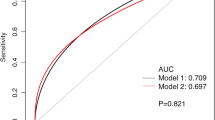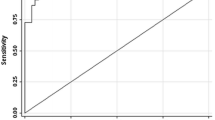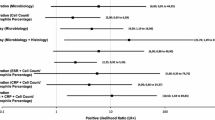Abstract
Background
The purpose of this study was to determine whether frozen sections can increase diagnostic values of serological tests for the assessment of periprosthetic joint infection (PJI) in patients without synovial fluid analyses.
Methods
A retrospective review of 128 revision arthroplasties (79 hips and 49 knees) from January 2016 to December 2017 was performed. Diagnosis of PJI was based on the Musculoskeletal Infection Society criteria for infection. Three diagnostic models for PJI, with model 1 including erythrocyte sedimentation rate (ESR) and C-reactive protein (CRP), model 2 including model 1 plus frozen sections > 5 polymorphonuclear neutrophil (PMN)s per high-power field (HPF), and model 3 including model 1 plus frozen sections > 10 PMNs per HPF, were developed. Then receiver operating characteristic (ROC) curves were generated, and the areas under the ROC curves (AUCs) were compared.
Results
The AUC of model 1, model 2, and model 3 was 79.40% [95% confidence interval (CI), 69.84 to 86.64%], 89.30% (95% CI, 82.93 to 93.92%), and 85.52% (95% CI, 78.44 to 91.4%), respectively. The AUC of model 1 was significantly lower than that of model 2 (p = 0.002) and model 3 (p = 0.039). Although the result was not significant (p = 0.132), there was a trend toward a higher AUC of model 2 than model 3.
Conclusions
This study reveals that intra-operative frozen sections significantly increased the performance of serum ESR and CRP in the diagnosis of PJI. The combination of serological tests and frozen sections for the assessment of PJI may be reliable in patients without synovial fluid analyses.


Similar content being viewed by others
References
Perfetti DC, Boylan MR, Naziri Q et al (2017) Have periprosthetic hip infection rates plateaued? J Arthroplast 32:2244–2247. https://doi.org/10.1016/j.arth.2017.02.027
Kurtz SM, Lau EC, Son M-S et al (2018) Are we winning or losing the battle with periprosthetic joint infection: trends in periprosthetic joint infection and mortality risk for the Medicare population. J Arthroplast. https://doi.org/10.1016/j.arth.2018.05.042
Parvizi J, Zmistowski B, Berbari EF et al (2011) New definition for periprosthetic joint infection: from the workgroup of the Musculoskeletal Infection Society. Clin Orthop Relat Res 469:2992–2994. https://doi.org/10.1007/s11999-011-2102-9
Parvizi J, Gehrke T (2014) Definition of periprosthetic joint infection. J Arthroplast 29:1331. https://doi.org/10.1016/j.arth.2014.03.009
Pandey R, Drakoulakis E, Athanasou NA (1999) An assessment of the histological criteria used to diagnose infection in hip revision arthroplasty tissues. J Clin Pathol 52:118–123
Tohtz SW, Müller M, Morawietz L et al (2010) Validity of frozen sections for analysis of periprosthetic loosening membranes. Clin Orthop Relat Res 468:762–768. https://doi.org/10.1007/s11999-009-1102-5
Athanasou NA, Pandey R, de Steiger R et al (1995) Diagnosis of infection by frozen section during revision arthroplasty. J Bone Joint Surg Br 77:28–33
Bori G, Soriano A, García S et al (2006) Low sensitivity of histology to predict the presence of microorganisms in suspected aseptic loosening of a joint prosthesis. Mod Pathol 19:874–877. https://doi.org/10.1038/modpathol.3800606
Bori G, Soriano A, García S et al (2009) Neutrophils in frozen section and type of microorganism isolated at the time of resection arthroplasty for the treatment of infection. Arch Orthop Trauma Surg 129:591–595. https://doi.org/10.1007/s00402-008-0679-6
Muñoz-Mahamud E, Bori G, García S et al (2013) Usefulness of histology for predicting infection at the time of hip revision for the treatment of Vancouver B2 periprosthetic fractures. J Arthroplast 28:1247–1250. https://doi.org/10.1016/j.arth.2012.12.016
Zhao X, Guo C, Zhao G-S et al (2013) Ten versus five polymorphonuclear leukocytes as threshold in frozen section tests for periprosthetic infection: a meta-analysis. J Arthroplast 28:913–917. https://doi.org/10.1016/j.arth.2012.10.015
Parvizi J, Tan TL, Goswami K et al (2018) The 2018 definition of periprosthetic hip and knee infection: an evidence-based and validated criteria. J Arthroplast. https://doi.org/10.1016/j.arth.2018.02.078
Francés Borrego A, Martínez FM, Cebrian Parra JL et al (2007) Diagnosis of infection in hip and knee revision surgery: intraoperative frozen section analysis. Int Orthop 31:33–37. https://doi.org/10.1007/s00264-005-0069-4
Banit DM, Kaufer H, Hartford JM (2002) Intraoperative frozen section analysis in revision total joint arthroplasty. Clin Orthop Relat Res:230–238
Partridge DG, Winnard C, Townsend R et al (2018) Joint aspiration, including culture of reaspirated saline after a “dry tap”, is sensitive and specific for the diagnosis of hip and knee prosthetic joint infection. Bone Joint J 100-B:749–754. https://doi.org/10.1302/0301-620X.100B6.BJJ-2017-0970.R2
Roberts P, Walters AJ, McMinn DJ (1992) Diagnosing infection in hip replacements. The use of fine-needle aspiration and radiometric culture. J Bone Joint Surg Br 74:265–269
Feldman DS, Lonner JH, Desai P, Zuckerman JD (1995) The role of intraoperative frozen sections in revision total joint arthroplasty. J Bone Joint Surg Am 77:1807–1813
DeLong ER, DeLong DM, Clarke-Pearson DL (1988) Comparing the areas under two or more correlated receiver operating characteristic curves: a nonparametric approach. Biometrics 44:837–845
Saleh A, George J, Faour M et al (2018) Serum biomarkers in periprosthetic joint infections. Bone & Joint Research 7:85–93. https://doi.org/10.1302/2046-3758.71.BJR-2017-0323
Greidanus NV, Masri BA, Garbuz DS et al (2007) Use of erythrocyte sedimentation rate and C-reactive protein level to diagnose infection before revision total knee arthroplasty: a prospective evaluation. J Bone Joint Surg Am 89:1409–1416. https://doi.org/10.2106/JBJS.D.02602
McArthur BA, Abdel MP, Taunton MJ et al (2015) Seronegative infections in hip and knee arthroplasty: periprosthetic infections with normal erythrocyte sedimentation rate and C-reactive protein level. Bone Joint J 97-B:939–944. https://doi.org/10.1302/0301-620X.97B7.35500
Yi PH, Cross MB, Moric M et al (2014) The 2013 Frank Stinchfield award: diagnosis of infection in the early postoperative period after total hip arthroplasty. Clin Orthop Relat Res 472:424–429. https://doi.org/10.1007/s11999-013-3089-1
Zmistowski B, Della Valle C, Bauer TW et al (2014) Diagnosis of periprosthetic joint infection. J Arthroplast 29:77–83. https://doi.org/10.1016/j.arth.2013.09.040
Kwiecien G, George J, Klika AK et al (2017) Intraoperative frozen section histology: matched for Musculoskeletal Infection Society criteria. J Arthroplast 32:223–227. https://doi.org/10.1016/j.arth.2016.06.019
Bori G, McNally MA, Athanasou N (2018) Histopathology in periprosthetic joint infection: when will the morphomolecular diagnosis be a reality? Biomed Res Int 2018:1–10. https://doi.org/10.1155/2018/1412701
Abdul-Karim FW, McGinnis MG, Kraay M et al (1998) Frozen section biopsy assessment for the presence of polymorphonuclear leukocytes in patients undergoing revision of arthroplasties. Mod Pathol 11:427–431
Della Valle CJ, Bogner E, Desai P et al (1999) Analysis of frozen sections of intraoperative specimens obtained at the time of reoperation after hip or knee resection arthroplasty for the treatment of infection. J Bone Joint Surg Am 81:684–689
Tsaras G, Maduka-Ezeh A, Inwards CY et al (2012) Utility of intraoperative frozen section histopathology in the diagnosis of periprosthetic joint infection: a systematic review and meta-analysis. J Bone Joint Surg Am 94:1700–1711. https://doi.org/10.2106/JBJS.J.00756
Parvizi J, Tan TL, Goswami K et al (2018) The 2018 definition of periprosthetic hip and knee infection: an evidence-based and validated criteria. J Arthroplast 33:1309–1314. e2. https://doi.org/10.1016/j.arth.2018.02.078
Acknowledgements
The authors would like to thank all staff from the participating departments and clinics.
Author information
Authors and Affiliations
Corresponding author
Ethics declarations
Competing interests
On behalf of all authors, the corresponding author states that there is no conflict of interest.
Rights and permissions
About this article
Cite this article
Xu, C., Guo, H. & Chen, JY. Intra-operative diagnosis of periprosthetic joint infection can rely on frozen sections in patients without synovial fluid analyses. International Orthopaedics (SICOT) 43, 1303–1308 (2019). https://doi.org/10.1007/s00264-018-4227-x
Received:
Accepted:
Published:
Issue Date:
DOI: https://doi.org/10.1007/s00264-018-4227-x




